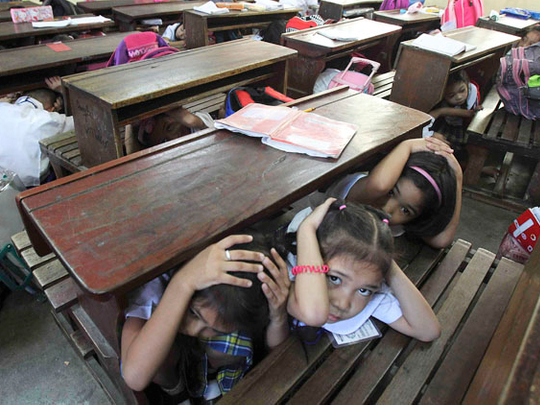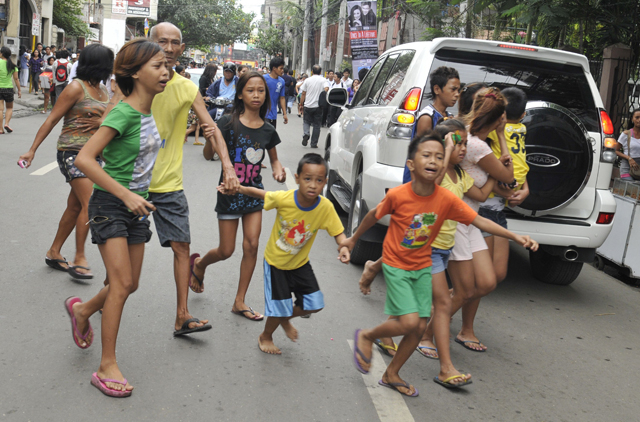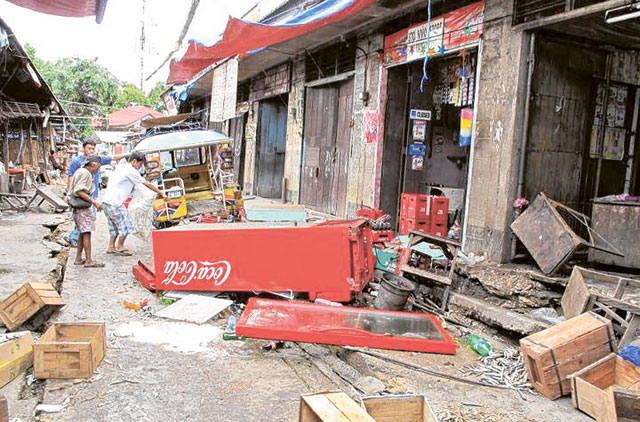
Manila: An earthquake measuring 6.9 on the Richter scale hit central Philippines on Monday, instantly killing at least 12 people, including two children.
The army put the death toll at 43 but the state disaster agency could not confirm the figure.
The earthquake generated panic in offices and schools. It also damaged buildings, roads and bridges, triggered deadly landslides and raised tsunami alert levels on Monday.
"Bernadette Raidan, aged nine, died when a wall collapsed on her in Tayasan," Undersecretary Benito Ramos, chief of the National Disaster Risk Reduction and Management Council (NDRRMC), told Gulf News.
Anna Fe Estrapedlia, 12, an elementary pupil, died when the wall of a chapel collapsed on her in Mompong village, Jimalalud, Negros Oriental province, Ramos said.
Betty Yap Manzano, 62, of Guihulngan, Negros Oriental, died in a landslide, a radio report said, adding that four more died in separate incidents in Negros Oriental.
That province was the one most battered by the quake in central Philippines, claiming 40 lives, according to reports.
After rescue operations were launched in areas that suffered two aftershocks, horrifying reports reached the NDRRMC office. Around 40 people were reportedly killed in two landslides in Planas village and on Guihulngan road. Forty houses were also buried in the two affected areas, the NDRRMC said.
Meanwhile, the quake triggered another landslide in Solongan village in Libertad town (Negros Oriental province) that buried more than 100 homes, the NDRRMC said. Rescue operations are continuing.
Rescuers dug with picks and shovels trying to reach dozens of people trapped under collapsed houses in the mountain village of Planas, Negros Oriental province.
The entire northern part of Negros Oriental was badly hit, Governor Roel Degamo confirmed in a radio interview. Two bridges that sustained cracks were closed, highways had cracks and were closed to traffic, churches, buildings and houses were damaged and power lines were toppled causing power outages, Degamo said.
The quake, tectonic in origin, occurred five kilometres northwest of Tayasan, Negros Oriental, 80km off Cebu, 70km off Bacolod and 70km off Dumaguete City on Negros, and 563km off Manila, at 11.49am, Philippine Institute of Volcanology and Seismology director Renato Solidum said.
The quake occurred 46km under a small body of water, Solidum said, adding that the strong quake "could result in a tsunami".However, the tsunami did not occur on Monday.
Worst-hit
Army commander Colonel Francisco Patrimonio said that in Guihulngan, which is close to the quake's epicentre, most of the victims had died as landslides buried homes, while others died as houses collapsed under the pressure of the quake.
"Some private homes collapsed along with our court house and parts of the public market. We got people out of the buildings but we could not evacuate the homes," police chief Senior Inspector Alvin Futalan said.
Patrimonio and other government officials warned the death toll may rise, with reports of dozens of other people injured or missing in Guihulngan and nearby areas.
However, they said it was impossible to determine the exact number of missing, as power and many phone lines in the region were down and roads to the mountainous areas were impassable because of the landslides.
Patrimonio said that authorities were having to deal with looting, as well as the immediate rescue efforts, as some people took advantage of the chaos.
"Looting is now rampant in Guihulngan which forced us to commit (more troops) with the Philippine national police," he said.
In Cebu, a popular tourist destination and the country's second biggest city with 2.3 million residents, hotel guests scrambled to higher floors as unfounded rumours that a huge tsunami was bearing down spread by text message.
"There is news going around of tsunami waves, so we are doing our best to keep everybody calm," Barbi Patino, a spokesman for the 17-story Parklane International Hotel, said shortly after the quake struck.
Civil defence chief Benito Ramos said the violent shaking of buildings in Cebu - 50 kilometres from the epicentre - led to broken windows and cracks on some walls.
But no high-rises sustained major damage and no deaths were reported in in the city.
Pedro Baldomino, a student in Cebu, said he saw many office workers leaving their buildings after a public announcement on radio warned people to brace for expected aftershocks.
"I was having lunch when the ground shook. Water spilled from glasses and plates clanked. Some of the diners rushed outside, some of us stayed underneath the tables," he said.
Almost four hours after the quake struck, a strong 6.2-magnitude aftershock hit the central Philippines, and then another struck measuring 6.0, causing further panic.
Over 200 less-powerful aftershocks were detected throughout the day, said provincial disaster monitoring executive director Angelo Tiongson.
Philippine government seismologists initially raised a precautionary tsunami alert over the quake, but lowered it two hours later.
The Hawaii-based Pacific Tsunami Warning Centre said there was no danger of a widespread destructive tsunami.
The Philippines sits on the Pacific "Ring of Fire" - a belt around the Pacific Ocean where friction between shifting tectonic plates causes frequent earthquakes and volcanic activity.
With input from AFP















